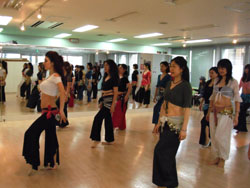Tania Luiz is a rare woman able to provoke hoots and screeches in a room packed with girls — and she does it all with her torso. The Osaka-based Portuguese belly dancing teacher and performer is profiting from a recent surge of interest in her art among Japanese females.
What goes by the misleadingly prosaic name of "belly dance" is called Oriental dance in its birthplace, Luiz explained in a recent interview. "It originated as folk dances in the Middle East and Near East. It has roots in Turkey, where by the 15th century there were already professional street dancers shaking metal castanets as they danced."
In Cairo, she explained, life imitated kitsch, as shows emulating European musical cabarets sprouted in the 1930s. While the dances were based on Egyptian folk dance traditions, the dancers' flashy costumes were patterned on Hollywood films on the "exotic" East.



